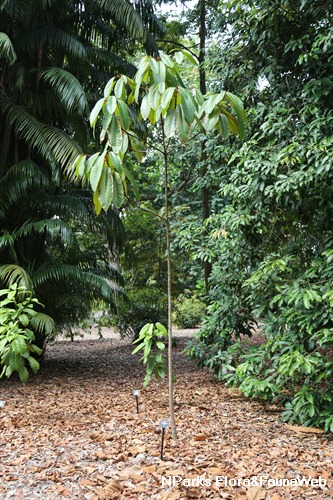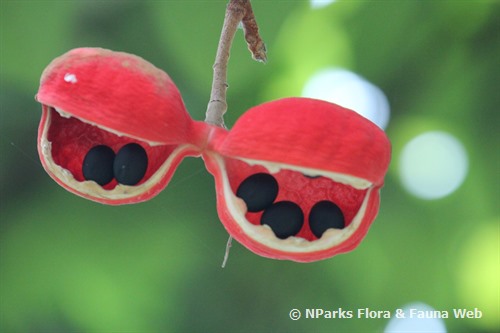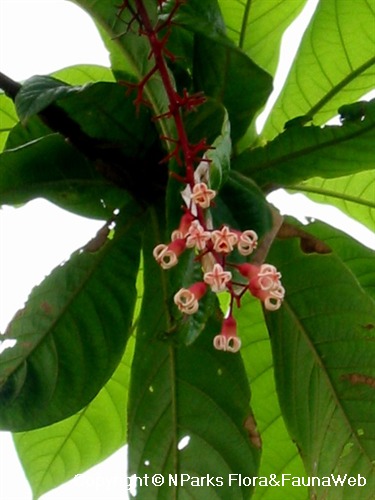
Back
Sterculia parviflora Roxb.
| Family Name: | Malvaceae |
| Synonyms: | Sterculia maingayi, Sterculia holttumii |
| Common Name: | Common Sterculia, Kelumpang Burong, Kelumpang Gajah, Samrong |
Name
Classifications and Characteristics
| Plant Division | Angiosperms (Flowering Seed Plants) (Dicotyledon) |
|---|---|
| Plant Growth Form | Tree (Medium (16m-30m)) |
| Lifespan (in Singapore) | Perennial |
| Mode of Nutrition | Autotrophic |
| Plant Shape | Rounded |
| Maximum Height | 24 m to 30 m |
Biogeography
| Native Distribution | Northeast India to Peninsular Malaysia, and Singapore |
|---|---|
| Native Habitat | Terrestrial (Primary Rainforest) |
| Preferred Climate Zone | Tropical |
| Local Conservation Status | Native to Singapore (Critically Endangered (CR)) |
Description and Ethnobotany
| Growth Form | It is a deciduous tree, up to 35 m tall. |
|---|---|
| Trunk | Its trunk is typically clear and straight, sometimes slightly buttressed. Bark greyish, flaking in coarse uneven bits. |
| Foliage | Its alternate, stalked leaves have leaf blades that are ovate, elliptic or elliptic-oblong, 8-20 cm by 4-10 cm. |
| Flowers | Its hairy flowers are pinkish in colour, borne on branched inflorescenes that are up to 20 cm long. |
| Fruit | Its velvety fruits are oblong follicles , 6-9 cm by 2-3 cm, ripening red in colour. |
| Habitat | It grows in tropical lowland primary and secondary jungles, as well as hill forests. |
| Associated Fauna | Its flowers are insect-pollinated. |
| Cultivation | Hardy tree tolerant of urban conditions. Planted trees produce fruits in 4-5 years. Propagate by seeds -- to aid germination, remove the black seedcoat and surrounding white pulp before sowing. Established saplings transplant well -- specimens with 10cm trunk diameter can be transplanted without need for crown pruning. |
| Etymology | Genus epithet 'Sterculia' named after Sterquilinus (or Sterculius), the early mythological Roman god of manuring and fertilization (where 'stercus' means 'dung' in Latin) -- alluding to how some species from this genus produce a foetid scent. Species epithet 'parviflora' means 'small-flowered' in Latin, a reference to the plant's blooms. |
Landscaping Features
| Landscaping | It is suitable for gardens, parks, and streetscapes for its attractive flowers, fruits and form. |
|---|---|
| Desirable Plant Features | Ornamental Fruits, Ornamental Flowers |
| Landscape Uses | General, Suitable for Roadsides, Parks & Gardens, Shade Providing Tree / Palm |
| Thematic Landscaping | Naturalistic Garden |
Fauna, Pollination and Dispersal
| Fauna Pollination Dispersal Associated Fauna | Bird-Attracting (Seeds) |
|---|---|
| Pollination Method(s) | Biotic (Fauna) (Insects (Ant, Beetle, Fly, Thrip, Wasp), Associated with: Flies, Beetles) |
| Seed or Spore Dispersal | Biotic (Fauna) |
Plant Care and Propagation
| Light Preference | Full Sun |
|---|---|
| Water Preference | Moderate Water |
| Plant Growth Rate | Moderate |
| Rootzone Tolerance | Fertile Loamy Soils, Well-Drained Soils, Moist Soils |
| Maintenance Requirements | Moderate |
| Propagation Method | Seed |
| Propagule Establishment Remarks | Before sowing, remove black seed coat & white pulp around seed to facilitate germination. |
Foliar
| Foliage Retention | Drought / Semi-Deciduous |
|---|---|
| Mature Foliage Colour(s) | Green |
| Mature Foliage Texture(s) | Raised / Sunken Veins, Thick, Leathery |
| Foliar Type | Simple / Unifoliate |
| Foliar Arrangement Along Stem | Alternate |
| Foliar Attachment to Stem | Petiolate |
| Foliar Shape(s) | Non-Palm Foliage (Oblong, Ovate, Elliptical) |
| Foliar Venation | Pinnate / Net |
| Foliar Margin | Entire |
| Foliar Apex - Tip | Acute, Acuminate |
| Foliar Base | Cordate |
| Typical Foliar Area | Mesophyll ( 45cm2 - 182.25 cm2 ) |
| Leaf Area Index (LAI) for Green Plot Ratio | 4.0 (Tree - Dense Canopy) |
Non - Foliar and Storage
| Trunk Type (Non Palm) | Woody |
|---|---|
| Bark Colour(s) | Greyish to pinkish |
| Mature Bark Texture | Peeling / Flaking / Papery |
| Stem Type & Modification | Woody |
| Root Type | Underground (Tap Root, Fibrous Root) |
| Mature Bark Texture Remarks | Coarsely flaky |
Floral (Angiosperm)
| Flower & Plant Sexuality | Unisexual & Bisexual Flowers(Sub-dioecious) |
| Flower Colour(s) | Pink, Yellow / Golden |
|---|---|
| Flower Texture(s) | Hairy / Hirsute |
| Flower Grouping | Cluster / Inflorescence |
| Flower Location | Axillary |
| Flower Size - Remarks | 0.85cm long & wide |
| Inflorescence Type | Raceme |
| Flowering Period | Once Yearly |
| Flowering Habit | Polycarpic |
| Inflorescence Size Remarks | Flower base matures from pale yellow-pink to completely reddish-pink. |
Fruit, Seed and Spore
| Mature Fruit Colour(s) | Red |
|---|---|
| Mature Fruit Texture(s) | Velvety / Furry / Tomentose |
| Fruit Classification | Simple Fruit |
| Fruit Type |
Image Repository
Others
| Master ID | 1848 |
|---|---|
| Species ID | 3141 |
| Flora Disclaimer | The information in this website has been compiled from reliable sources, such as reference works on medicinal plants. It is not a substitute for medical advice or treatment and NParks does not purport to provide any medical advice. Readers should always consult his/her physician before using or consuming a plant for medicinal purposes. |

_lowres.jpg)
_lowres.jpg)
_lowres.jpg)


_lowres.jpg)


_lowres.jpg)
_lowres.jpg)
_lowres.jpg)
_lowres.jpg)




_lowres.jpg)


